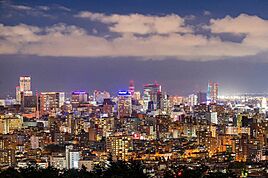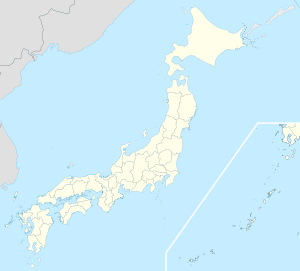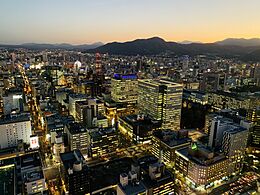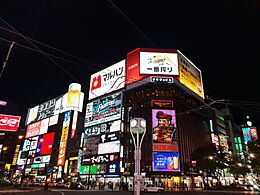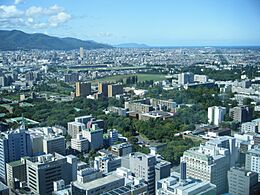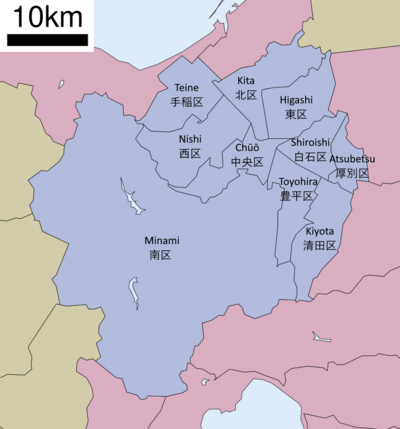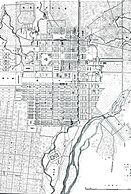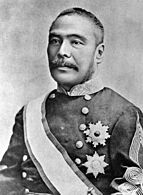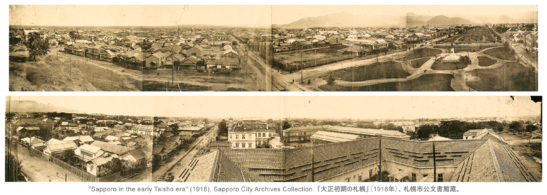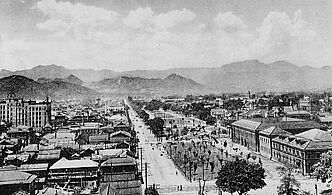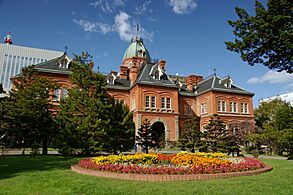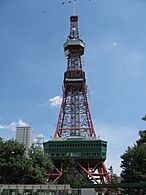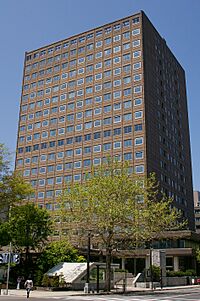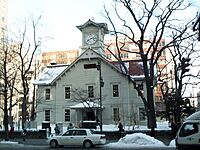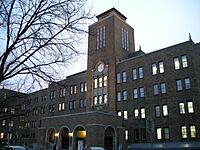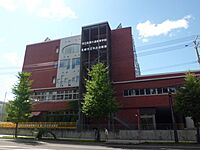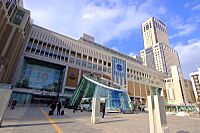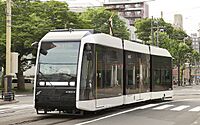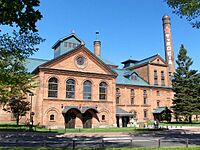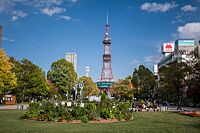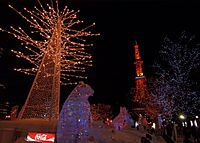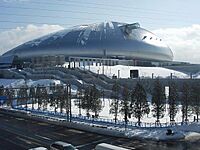Sapporo facts for kids
Quick facts for kids
Sapporo
札幌市
|
|||||||||||||
|---|---|---|---|---|---|---|---|---|---|---|---|---|---|
| City of Sapporo | |||||||||||||
|
Left to right from top:Sapporo City Skyline from Asahiyama Memorial Park ; Sapporo Clock Tower; Odori Park; Sapporo Beer Museum; Susukino area; Historical Village of Hokkaido; and Jozankei Onsen
|
|||||||||||||
|
|||||||||||||
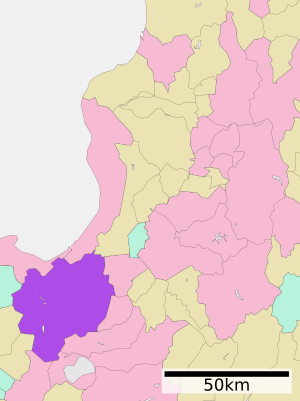
Location of Sapporo in Hokkaido (Ishikari Subprefecture)
|
|||||||||||||
| Country | |||||||||||||
| Region | Hokkaido | ||||||||||||
| Prefecture | Hokkaido (Ishikari Subprefecture) | ||||||||||||
| Area | |||||||||||||
| • Designated city | 1,121.26 km2 (432.92 sq mi) | ||||||||||||
| Population
(July 31, 2023)
|
|||||||||||||
| • Designated city | 1,959,750 | ||||||||||||
| • Density | 1,747.810/km2 (4,526.81/sq mi) | ||||||||||||
| • Metro | 2,661,000 | ||||||||||||
| Time zone | UTC+09:00 (JST) | ||||||||||||
| City hall address | 2-1-1 Kita-ichijō-nishi, Chūō-ku, Sapporo-shi, Hokkaido 060-8611 |
||||||||||||
| Climate | Dfa | ||||||||||||
|
|||||||||||||
| Sapporo | |||||
|---|---|---|---|---|---|

"Sapporo" in kanji
|
|||||
| Japanese name | |||||
| Kanji | 札幌 | ||||
| Hiragana | さっぽろ | ||||
| Katakana | サッポロ | ||||
|
|||||
Sapporo (札幌市, Sapporo-shi) is a big city in Japan. It is the largest city north of Tokyo. It is also the biggest city on Hokkaido, which is Japan's northernmost main island. Sapporo is the fifth most populated city in Japan. About 1,959,750 people lived there as of July 31, 2023.
Sapporo is the capital city of Hokkaido Prefecture. It is also the capital of Ishikari Subprefecture. The city is in the southwest of Hokkaido. It sits on flat land near the Toyohira River. This river flows into the Ishikari River. Sapporo is the main center for culture, money, and government in Hokkaido.
Long ago, the Ainu lived in the Sapporo area. They settled here more than 15,000 years ago. Later, in the late 1800s, more people from other parts of Japan moved to Sapporo.
Sapporo hosted the 1972 Winter Olympics. This was the first time the Winter Olympics were held in Asia. Japan had hosted the 1964 Summer Olympics before. The city also hosted games for the 2002 FIFA World Cup and the 2019 Rugby World Cup. Sapporo has hosted the Asian Winter Games three times.
Sapporo is known as one of the most attractive cities in Japan. The yearly Sapporo Snow Festival brings over 2 million visitors. Other famous places include the Sapporo Beer Museum and the Sapporo TV Tower. These are located near Odori Park. Hokkaido University is also in Sapporo, just north of Sapporo Station. You can fly to Sapporo using Okadama Airport or New Chitose Airport.
Contents
About Sapporo
What's in a Name?
Sapporo's name comes from the Ainu language. The Ainu word is sat poro pet. This means "dry, great river." It refers to the Toyohira River.
City Views
- Gallery
-
Central business district of Sapporo City at dusk (2020)
Geography of Sapporo
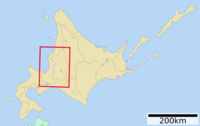
Sapporo is in the southwest part of the Ishikari Plain. It is built on the flat land near the Toyohira River. This river is a branch of the Ishikari River. Sapporo is part of Ishikari Subprefecture. The city's main roads are laid out in a grid pattern.
The western and southern parts of Sapporo have many mountains. These include Mount Teine, Maruyama, and Mount Moiwa. Many rivers also flow through the area, like the Ishikari River and Sōsei River. Sapporo is about 29 meters (95 feet) above sea level.
Sapporo has many beautiful parks. Odori Park is in the city center. It hosts many events and festivals all year. Moerenuma Park is another large park. It was designed by the famous artist Isamu Noguchi.
Sapporo is surrounded by other cities. These include Ishikari, Ebetsu, and Chitose.
Sapporo's Climate
| Weather chart for Sapporo | |||||||||||||||||||||||||||||||||||||||||||||||
|---|---|---|---|---|---|---|---|---|---|---|---|---|---|---|---|---|---|---|---|---|---|---|---|---|---|---|---|---|---|---|---|---|---|---|---|---|---|---|---|---|---|---|---|---|---|---|---|
| J | F | M | A | M | J | J | A | S | O | N | D | ||||||||||||||||||||||||||||||||||||
|
108
-0
-6
|
92
0
-6
|
78
5
-2
|
55
12
3
|
56
18
9
|
60
22
13
|
91
25
18
|
127
26
19
|
142
23
15
|
110
16
8
|
114
9
2
|
115
2
-4
|
||||||||||||||||||||||||||||||||||||
| temperatures in °C precipitation totals in mm |
|||||||||||||||||||||||||||||||||||||||||||||||
|
Imperial conversion
|
|||||||||||||||||||||||||||||||||||||||||||||||
Sapporo has a humid continental climate. This means it has big temperature changes between summer and winter. Summers are usually warm and humid, but not too hot. Winters are cold and get a lot of snow. Sapporo gets about 4.79 meters (15.7 feet) of snow each year.
This heavy snowfall allows Sapporo to hold many snow festivals. The city gets so much snow because of cold air coming from Siberia. The average temperature in Sapporo is about 8.5°C (47.3°F). The city gets about 1100 mm (43 inches) of rain each year.
The hottest temperature ever in Sapporo was 36.3°C (97.3°F) on August 23, 2023. The coldest was -28.5°C (-19.3°F) on February 1, 1929.
| Climate data for Sapporo (1991−2020 normals, extremes 1877−present) | |||||||||||||
|---|---|---|---|---|---|---|---|---|---|---|---|---|---|
| Month | Jan | Feb | Mar | Apr | May | Jun | Jul | Aug | Sep | Oct | Nov | Dec | Year |
| Record high °C (°F) | 11.2 (52.2) |
10.8 (51.4) |
18.3 (64.9) |
28.0 (82.4) |
33.7 (92.7) |
34.2 (93.6) |
36.0 (96.8) |
36.3 (97.3) |
32.7 (90.9) |
27.3 (81.1) |
22.4 (72.3) |
14.8 (58.6) |
36.3 (97.3) |
| Mean maximum °C (°F) | 5.1 (41.2) |
7.0 (44.6) |
12.3 (54.1) |
21.3 (70.3) |
27.4 (81.3) |
29.0 (84.2) |
31.4 (88.5) |
32.0 (89.6) |
28.8 (83.8) |
22.7 (72.9) |
17.2 (63.0) |
9.4 (48.9) |
32.7 (90.9) |
| Mean daily maximum °C (°F) | −0.4 (31.3) |
0.4 (32.7) |
4.5 (40.1) |
11.7 (53.1) |
17.9 (64.2) |
21.8 (71.2) |
25.4 (77.7) |
26.4 (79.5) |
22.8 (73.0) |
16.4 (61.5) |
8.7 (47.7) |
2.0 (35.6) |
13.1 (55.6) |
| Daily mean °C (°F) | −3.2 (26.2) |
−2.7 (27.1) |
1.1 (34.0) |
7.3 (45.1) |
13.0 (55.4) |
17.0 (62.6) |
21.1 (70.0) |
22.3 (72.1) |
18.6 (65.5) |
12.1 (53.8) |
5.2 (41.4) |
−0.9 (30.4) |
9.2 (48.6) |
| Mean daily minimum °C (°F) | −6.4 (20.5) |
−6.2 (20.8) |
−2.4 (27.7) |
3.4 (38.1) |
9.0 (48.2) |
13.4 (56.1) |
17.9 (64.2) |
19.1 (66.4) |
14.8 (58.6) |
8.0 (46.4) |
1.6 (34.9) |
−4.0 (24.8) |
5.7 (42.3) |
| Mean minimum °C (°F) | −11.8 (10.8) |
−11.7 (10.9) |
−7.9 (17.8) |
−1.4 (29.5) |
3.9 (39.0) |
9.0 (48.2) |
13.7 (56.7) |
14.7 (58.5) |
8.7 (47.7) |
2.1 (35.8) |
−4.6 (23.7) |
−9.0 (15.8) |
−12.8 (9.0) |
| Record low °C (°F) | −27.0 (−16.6) |
−28.5 (−19.3) |
−22.6 (−8.7) |
−14.6 (5.7) |
−4.2 (24.4) |
0.0 (32.0) |
5.2 (41.4) |
5.3 (41.5) |
−0.9 (30.4) |
−4.4 (24.1) |
−15.5 (4.1) |
−24.7 (−12.5) |
−28.5 (−19.3) |
| Average precipitation mm (inches) | 108.4 (4.27) |
91.9 (3.62) |
77.6 (3.06) |
54.6 (2.15) |
55.5 (2.19) |
60.4 (2.38) |
90.7 (3.57) |
126.8 (4.99) |
142.2 (5.60) |
109.9 (4.33) |
113.8 (4.48) |
114.5 (4.51) |
1,146.1 (45.12) |
| Average snowfall cm (inches) | 137 (54) |
116 (46) |
74 (29) |
6 (2.4) |
0 (0) |
0 (0) |
0 (0) |
0 (0) |
0 (0) |
1 (0.4) |
30 (12) |
113 (44) |
479 (189) |
| Average extreme snow depth cm (inches) | 76 (30) |
95 (37) |
82 (32) |
22 (8.7) |
0 (0) |
0 (0) |
0 (0) |
0 (0) |
0 (0) |
1 (0.4) |
15 (5.9) |
47 (19) |
97 (38) |
| Average precipitation days (≥ 0.5 mm) | 22.1 | 19.2 | 18.3 | 12.3 | 10.2 | 9.3 | 9.4 | 10.5 | 11.7 | 14.0 | 18.3 | 19.9 | 175.1 |
| Average snowy days (≥ 0.2 cm) | 29.1 | 25.2 | 22.5 | 6.7 | 0.1 | 0.0 | 0.0 | 0.0 | 0.0 | 0.9 | 13.5 | 26.8 | 124.4 |
| Average relative humidity (%) | 69 | 68 | 65 | 61 | 65 | 72 | 75 | 75 | 71 | 67 | 67 | 68 | 69 |
| Average dew point °C (°F) | −8 (18) |
−8 (18) |
−5 (23) |
−1 (30) |
6 (43) |
12 (54) |
16 (61) |
18 (64) |
13 (55) |
6 (43) |
0 (32) |
−6 (21) |
4 (39) |
| Mean monthly sunshine hours | 90.4 | 103.5 | 144.7 | 175.8 | 200.4 | 180.0 | 168.0 | 168.1 | 159.3 | 145.9 | 99.1 | 82.7 | 1,718 |
| Average ultraviolet index | 1 | 1 | 1 | 3 | 4 | 5 | 5 | 5 | 4 | 2 | 1 | 1 | 3 |
| Source 1: Japan Meteorological Agency | |||||||||||||
| Source 2: Weather Atlas (UV), Time and Date (dewpoints, 2005–2015), Météo Climat | |||||||||||||
Sapporo's Wards
Sapporo is divided into ten smaller areas called wards (ku).
| Name | Kanji | Population | Land area in km2 | Pop. density
per km2 |
Map of Sapporo | |
|---|---|---|---|---|---|---|
| 1 | Atsubetsu-ku | 厚別区 | 127,299 | 24.38 | 5,221 | |
| 2 | Chūō-ku | 中央区 | 237,761 | 46.42 | 5,122 | |
| 3 | Higashi-ku | 東区 | 261,901 | 56.97 | 4,597 | |
| 4 | Kita-ku | 北区 | 286,026 | 63.57 | 4,499 | |
| 5 | Kiyota-ku | 清田区 | 113,556 | 59.87 | 1,897 | |
| 6 | Minami-ku | 南区 | 136,774 | 657.48 | 208 | |
| 7 | Nishi-ku | 西区 | 216,835 | 75.10 | 2,887 | |
| 8 | Shiroishi-ku | 白石区 | 213,310 | 34.47 | 6,188 | |
| 9 | Teine-ku | 手稲区 | 141,886 | 56.77 | 2,499 | |
| 10 | Toyohira-ku | 豊平区 | 223,408 | 46.23 | 4,833 |
How Many People Live Here?
The first count of people in Sapporo was in 1873. At that time, 1,785 people lived there. As of July 31, 2023, Sapporo has about 1,959,750 people. This means there are about 1,748 people per square kilometer. The city covers a total area of 1121.26 square kilometers.
| Historical population | ||||||||||||||||||||||||||||||||||||||||||||||||||||||||||||||||||||||
|---|---|---|---|---|---|---|---|---|---|---|---|---|---|---|---|---|---|---|---|---|---|---|---|---|---|---|---|---|---|---|---|---|---|---|---|---|---|---|---|---|---|---|---|---|---|---|---|---|---|---|---|---|---|---|---|---|---|---|---|---|---|---|---|---|---|---|---|---|---|---|
|
|
|||||||||||||||||||||||||||||||||||||||||||||||||||||||||||||||||||||
| Source: Statistics Bureau [1] | ||||||||||||||||||||||||||||||||||||||||||||||||||||||||||||||||||||||
Nearby Towns and Cities
Sapporo is close to many other places.
- Ishikari Subprefecture
- Ebetsu
- Kitahiroshima
- Ishikari
- Eniwa
- Chitose
- Ishikari District:Tōbetsu
- Shiribeshi Subprefecture
- Otaru
- Abuta District:Kimobetsu
- Abuta District:Kyōgoku
- Yoichi District:Akaigawa
- Iburi Subprefecture
- Date
History of Sapporo
Early Days
Long before Sapporo was a city, the Ainu lived in this area. In 1866, a canal was built here, which brought early settlers. The year 1868 is seen as Sapporo's "birth." The new Japanese government decided that the old capital of Hokkaido, Hakodate, was not in a good spot. So, they chose the Ishikari Plain for a new capital. This plain was flat and wide, which was rare in mountainous Hokkaido.
From 1870 to 1871, the Hokkaido Development Commission asked the American government for help. Horace Capron, a US Secretary of Agriculture, became an advisor. Building started around Odori Park, which is still a green space in the city center. The city was planned with a grid of straight streets. More Japanese people moved to Hokkaido, and Sapporo grew. In 1882, the Development Commission was no longer needed. In 1871, the Hokkaidō Shrine was built.
Edwin Dun came to Sapporo in 1876 to start farms for sheep and cattle. He also taught people how to raise pigs and make dairy products. William S. Clark was the first vice-president of the Sapporo Agricultural College (now Hokkaido University). He taught science and shared Christian ideas.
In 1880, the Sapporo area was named "Sapporo-ku" (Sapporo Ward). A railroad was built between Sapporo and Otaru. The Hōheikan, a hotel for important visitors, was built near Odori Park. It was later moved to Nakajima Park. In 1882, Hokkaido was divided into three areas: Hakodate, Sapporo, and Nemuro. The city part stayed Sapporo-ku.
In 1886, the three areas were combined again. The Former Hokkaidō Government Office building was built in 1888. It is a red-brick building in an American style. Sapporo-ku managed the surrounding area until 1899. After that, Sapporo-ku became its own self-governing area.
- Gallery
The 1900s
In 1907, Sapporo Agricultural College became part of Tohoku Imperial University. In 1910, some nearby villages joined Sapporo-ku.
The Sapporo Streetcar started in 1918. Hokkaido Imperial University was also founded in Sapporo-ku. In 1922, Sapporo-ku officially became Sapporo City. The Sapporo Municipal Bus System began in 1930. Sapporo was chosen to host the 1940 Winter Olympics in 1937, but the event was cancelled because of a war. Okadama Airport was built in 1942. During World War II, American planes bombed the city in July 1945.
The first Sapporo Snow Festival was held in 1950. More villages and towns joined Sapporo City in the 1950s and 1960s. This made the city much larger.
In 1968, Sapporo celebrated its 100th birthday. The Sapporo Municipal Subway opened in 1971. This made Sapporo the fourth city in Japan with a subway. From February 3 to 13, 1972, Sapporo hosted the 1972 Winter Olympics. On April 1, 1972, Sapporo became a "city designated by government ordinance," and seven wards were created. The subway system expanded in 1976 and 1988. In 1989, Atsubetsu-ku and Teine-ku became separate wards. New yearly events like the Pacific Music Festival and Yosakoi Sōran Festival began. A professional football team, Consadole Sapporo, started in 1996. In 1997, Kiyota-ku separated from Toyohira-ku.
- Gallery
-
The Sapporo TV Tower was built in 1957.
The 2000s and Beyond

The Sapporo Dome was finished in 2001. It hosted three games during the 2002 FIFA World Cup. In 2004, Sapporo became home to a baseball team, Hokkaido Nippon-Ham Fighters. They won the 2006 Japan Series.
The 34th G8 summit was held near Sapporo in 2008. People marched in Sapporo to protest. The Hokkaidō Shinkansen (bullet train) line is planned to reach Sapporo by 2030.
International Connections
Sapporo has special relationships with cities around the world. These are called "sister cities."
| City | Country | State | Since |
|---|---|---|---|
| Portland | Oregon | November 17, 1959 | |
| Munich | Bavaria | August 28, 1972 | |
| Shenyang | Liaoning | November 18, 1980 | |
| Denver | Colorado | September 1982 | |
| Novosibirsk | Novosibirsk Oblast | June 13, 1990 | |
| Daejeon | South Chungcheong | October 22, 2010 |
Sapporo also works with these cities:
| City | Country | State |
|---|---|---|
| Balikpapan | East Kalimantan | |
| Brisbane | Queensland | |
| Davao City | Davao Region | |
| Seattle | Washington |
Japanese Sister Cities
Sapporo also has sister city relationships within Japan.
| City | Prefecture | Region | Since |
|---|---|---|---|
| Hamamatsu | Chūbu region | May 14, 2009 | |
| Matsumoto | September 6, 2010 | ||
| Kagoshima | Kyūshū region | November 16, 2013 |
Economy of Sapporo
Sapporo's economy is mostly about services. Key industries include technology, shopping, and tourism. Many people visit Sapporo for winter sports and summer activities. This is because of its cool climate.
The city is also a manufacturing hub in Hokkaido. It makes food products, metal items, steel, and drinks. Sapporo Breweries, founded in 1876, is a big company here.
Several airlines have their main offices in Sapporo. These include Hokkaido International Airlines (Air Do). Other companies like Crypton Future Media and Royce' are also based here.
Education in Sapporo
Sapporo has many universities and schools.
Universities
- National Universities
- Hokkaido University
- Hokkaido University of Education
- Public Universities
- Sapporo Medical University
- Sapporo City University
- Private Universities
- Sapporo University
- Hokusei Gakuen University
- Hokkai School of Commerce
- Hokkai Gakuen University
- Fuji Women's University
- Sapporo International University
- Tenshi College
- Health Sciences University of Hokkaido
- Sapporo Ōtani University
- Hokkaido Tokai University
- Hokkaido Musashi Women's Junior College
- Hokkaido Bunkyo University
- Hokkaido University of Science
- Koen Gakuen Women's Junior College
- Hokkaido Institute of Technology
- Hokkaido College of Pharmacy
- Sapporo University of Health Sciences
- Japan Health Care College
Schools
Sapporo Odori High School offers Japanese language classes for foreign students. The city also has two private international schools:
- Hokkaido International School
- Hokkaido Korean Primary, Middle and High School
Getting Around Sapporo
Sapporo has a streetcar line, three JR Hokkaido train lines, and three subway lines. There are also many bus lines. The Sapporo Subway trains use rubber tires.
Airports
Sapporo has two airports. Okadama Airport offers flights within Hokkaido and to nearby regions. New Chitose Airport is a larger international airport. It is about 30 miles (48 km) away in Chitose. Fast trains connect it to Sapporo in about 40 minutes. The route between New Chitose and Tokyo's Haneda Airport is one of the busiest in the world.
Trains
- JR Hokkaido Stations in Sapporo
High-Speed Rail
- JR Hokkaido
- Hokkaido Shinkansen (expected 2032)
Regular Train Lines
- JR Hokkaido
- Hakodate Line: Hoshimi – Hoshioki – Inaho – Teine – Inazumi Kōen – Hassamu – Hassamu Chūō – Kotoni – Sōen – Sapporo – Naebo – Shiroishi – Atsubetsu – Shinrinkōen
- Chitose Line: Heiwa – Shin Sapporo – Kami Nopporo
- Sasshō Line (Gakuentoshi Line): Sōen – Hachiken – Shinkawa – Shinkotoni – Taihei – Yurigahara – Shinoro – Takuhoku – Ainosato Kyōikudai – Ainosato Kōen
Subways
- Sapporo Municipal Subway provides city train service.
Trams
- Sapporo Streetcar
Ropeways
- Mount Moiwa Ropeway
- Teineyama Ropeway
Buses
An airport shuttle bus runs daily to hotels in Sapporo. SkyExpress also provides transport to ski resorts in Hokkaido.
Fun Things to See and Do
Places to Visit
- The Former Hokkaidō Government Office Building
- The Sapporo Clock Tower
- The Hokkaidō Shrine
- Nishino Shrine
- Hokkaido Museum
- Historical Village of Hokkaido
- The Sapporo City Archive Museum
- The Edwin Dun Memorial Hall
- Hokkaido University & Hokkaido University Museum
- The Sapporo Beer Museum & Sapporo Factory
- The Sapporo TV Tower
- The Sapporo Convention Center
- The Sapporo Salmon Museum in Makomanai Park
- The Sunpiazza Aquarium
The Sapporo JR Tower is next to Sapporo Station.
Susukino district has Sapporo Ramen Yokocho and Norubesa, a building with a Ferris wheel. It also has the Tanuki Kōji Shopping Arcade, the city's oldest shopping mall.
The Jōzankei area in Minami-ku has many hotels with hot springs (onsen).
The Peace Pagoda is on Mount Moiwa. It was built in 1959 to remember peace after World War II. It holds some of the Buddha's ashes.
Parks and Gardens
- Odori Park
- Nakajima Park
- Maruyama Park is near the Hokkaido Shrine. It has the Maruyama Zoo.
- Moerenuma Park
- Nishioka Park is a natural area with a pond and forest. It is home to many wild birds.
- Asahiyama Memorial Park offers great city views.
- Hokkaido University Botanical Gardens and The Chizaki Rose Garden
- Hitsujigaoka Observation Hill has a sheep farm and a statue of William S. Clark.
Culture in Sapporo
Music Scene
- 1934 – The International Contemporary Music Festival was held.
- 1960 – The Sapporo Symphony Orchestra was founded.
- 1974 – Opera singer Maria Callas gave her last public performance here.
- 1986 – The Sapporo Art Park opened with an outdoor stage and art hall.
- 1990 – The Pacific Music Festival (PMF) began.
- 1997 – The Sapporo Concert Hall Kitara opened.
Art and Museums
- The Hokkaido Museum of Modern Art shows works by Hokkaido artists.
- The Hongō Shin Memorial Museum of Sculpture has over 1,800 works by artist Hongō Shin.
- The Sapporo Art Park has an art museum with outdoor sculptures.
- The Moerenuma Park includes the Glass Pyramid, designed by Isamu Noguchi.
- The Migishi Kotaro Museum of Art
- The Miyanomori Art Museum
- Sapporo is part of the UNESCO Creative Cities Network for Media Arts since 2013.
Literature
- The Hokkaido Museum of Literature
- Takeo Arishima Residence in Sapporo Art Park
- Junichi Watanabe Museum of Literature
Film
- The movie The Idiot (1951 film) by Akira Kurosawa was filmed here.
- Theater Kino
- The Sapporo International Short Film Festival and Market
Video Games
Sapporo has inspired places in video games:
- Yakuza 5
- Persona 5 Strikers
- Jubilife City in Pokémon Diamond and Pearl, Pokémon Platinum, and Pokémon Legends: Arceus is based on Sapporo.
Events and Festivals
- February: The Sapporo Snow Festival. This famous festival features huge snow and ice sculptures. The main site is Odori Park.
- May: The Sapporo Lilac Festival. People enjoy lilac flowers, wine, and live music.
- June: The Yosakoi Soran Festival. Dance teams perform to music based on a traditional Japanese song. Dancers wear special costumes and compete. In 2006, about 45,000 dancers took part.
- Summer: The Sapporo Summer Festival. People enjoy beer gardens in Odori Park and on the streets of Susukino.
- September: The Sapporo Autumn Festival.
- December: A Christmas market in Odori Park, like those in Germany.
From November to January, many lights decorate the city for the Sapporo White Illumination.
Food in Sapporo
Sapporo is famous for its food!
- Sapporo Brewery is from here.
- Shiroi Koibito (白い恋人) are white chocolate biscuits.
- Miso Ramen was created here. Kouraku Ramen Meitengai in Susukino is an alley with many miso ramen restaurants.
- Haskap is a local berry, similar to blueberries.
- Soup Curry is a soupy curry with vegetables and chicken.
- Jingisukan is a grilled lamb dish, named after Genghis Khan.
- Sapporo Sweets are candies made with local Hokkaido ingredients.
- Sapporo is known for fresh seafood like salmon, sea urchin, and especially crab. Many types of crab are served, such as horsehair crab and king crab.
Sports in Sapporo
The Sapporo Dome was built in 2001. It is home to the local professional football team, Hokkaido Consadole Sapporo.
ES CON Field Hokkaido is a baseball park in Kitahiroshima. It is home to the Hokkaido Nippon-Ham Fighters baseball team. It opened in March 2023. Before that, the Fighters played at Sapporo Dome.
Winter Sports
Sapporo was chosen to host the 1940 Winter Olympics, but they were cancelled. In 1972, Sapporo successfully hosted the 11th Winter Olympics. Some Olympic structures, like the ski jumps at Miyanomori and Okurayama, are still used today. Sapporo is thinking about bidding for the 2034 Winter Olympics.
In 2002, Sapporo Dome hosted three games for the 2002 FIFA World Cup. In 2006, Sapporo hosted basketball and volleyball championships. In 2007, it hosted the FIS Nordic World Ski Championships. Sapporo has hosted the Asian Winter Games twice. It also hosted games during the 2019 Rugby World Cup.
Skiing is a very popular sport in Sapporo. Almost all children learn to ski in school. Okurayama Elementary School even has its own ski hill! There are several ski hills in the city, including Moiwayama and Sapporo Teine.
Many sports stadiums are in Sapporo. The Sapporo Community Dome (Tsu-Dome) hosts a large flea market and sports events. The Makomanai Ice Arena was used for the 1972 Olympics. Other big sports places include the Makomanai Open Stadium and the Hokkaido Prefectural Sports Center. This center is home to the professional basketball team, Levanga Hokkaido.
Toyota Big Air was a big international snowboarding event held yearly at Sapporo Dome.
Professional Sports Teams
| Club | Sport | League | Venue | Established |
|---|---|---|---|---|
| Hokkaido Nippon-Ham Fighters | Baseball | Nippon Professional Baseball | Es Con Field Hokkaido | 2004 |
| Levanga Hokkaido | Basketball | B.League Division 1 | Hokkaido Prefectural Sports Center, Tsukisamu Dome |
2006 |
| Hokkaido Consadole Sapporo | Football (soccer) | J1 League | Sapporo Atsubetsu Park Stadium, Sapporo Dome |
1996 |
- J.League – Hokkaido Consadole Sapporo (plays in J1 League)
- NPB – Hokkaido Nippon Ham Fighters (plays in Pacific League)
See also
 In Spanish: Sapporo para niños
In Spanish: Sapporo para niños


